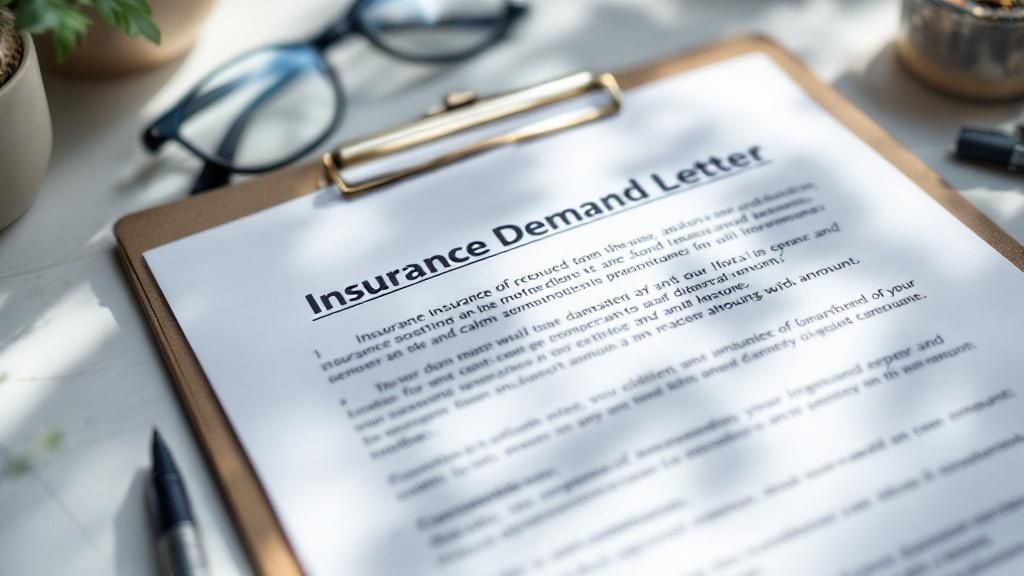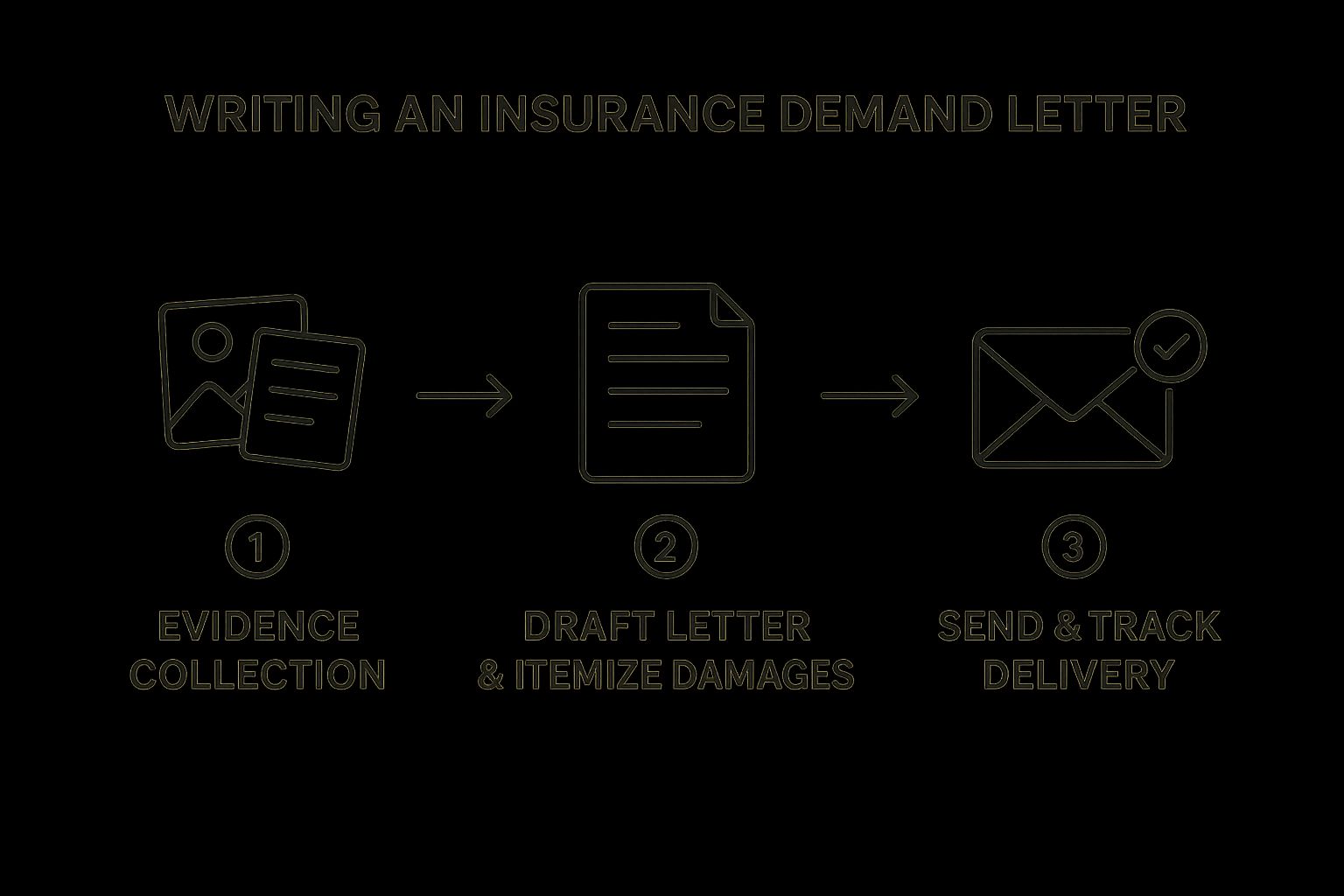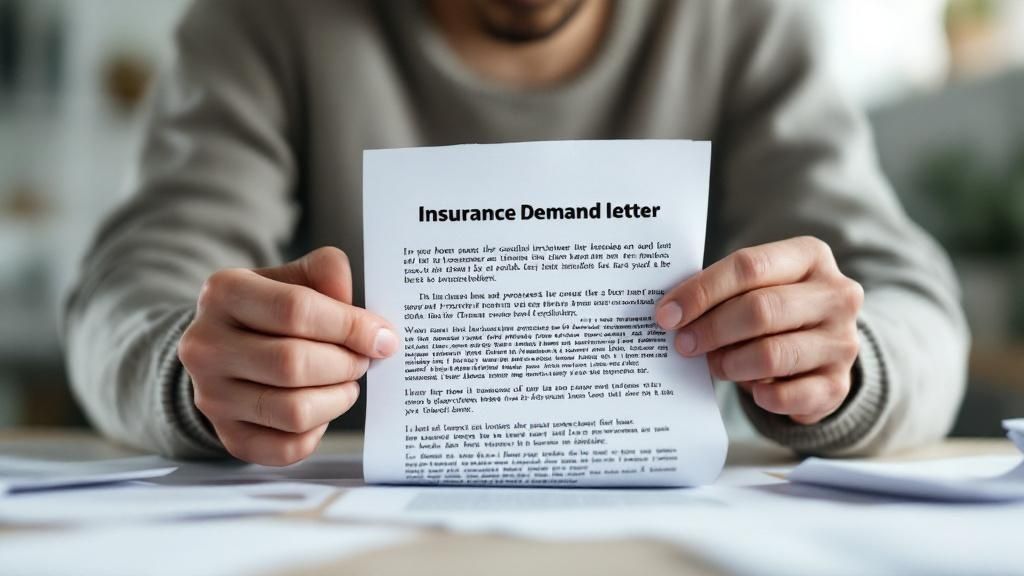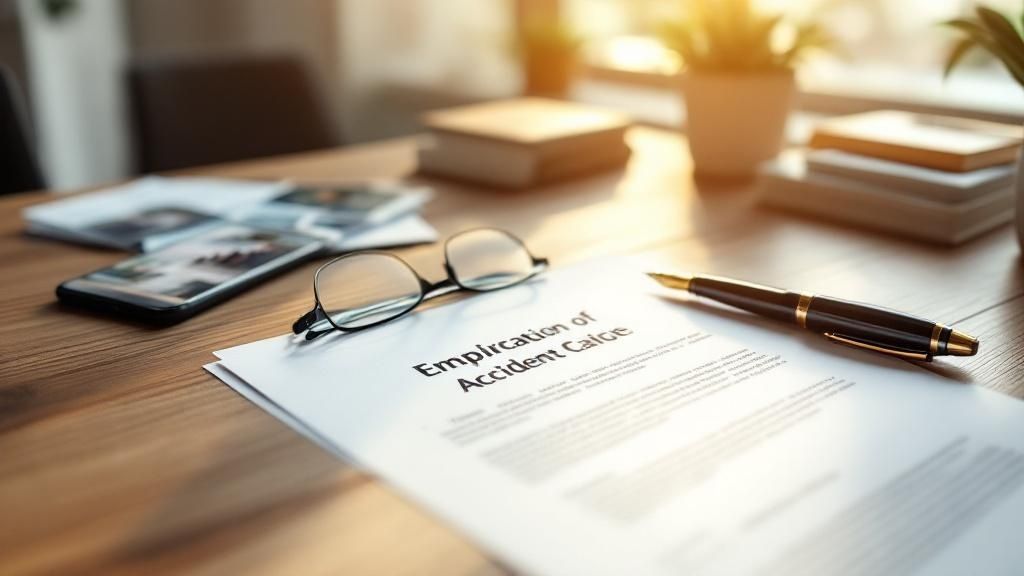Think of an insurance demand letter not just as a request for money, but as your opening argument in a settlement negotiation. It's a formal, structured document where you lay out your case for the insurance adjuster, covering the facts of the incident, the details of your injuries, and the full financial impact. A well-written letter sets a serious, professional tone right from the start, showing you've done your homework and can back up every dollar you're claiming.
What an Insurance Demand Letter Really Does

It's a common mistake to treat a demand letter like a simple bill you're sending to the insurance company. A far better approach is to see it as your first—and most important—chance to tell your side of the story. This letter is the foundation for every conversation you'll have with the insurer from this point forward. Its goal is to present a clear, logical, and evidence-backed argument that persuades the adjuster that your settlement demand is reasonable and justified.
A strong letter goes beyond just listing your medical bills. It weaves a narrative about the accident and its aftermath, all from your perspective. By controlling the story from day one, you stop the insurance company from setting the terms of the conversation.
Shifting the Power in Negotiations
Let's be clear: an adjuster's primary goal is to settle claims for the lowest amount possible. If you send a vague, poorly organized, or overly emotional letter, you're handing them all the power. They can easily dismiss it, counter with a frustratingly low offer, or simply drag their feet, hoping you'll get tired and take whatever they're willing to give.
A professional, meticulously documented demand letter completely changes that dynamic. It's a clear signal to the adjuster that you're organized, you're serious, and you're prepared to prove your case. This one document can shift the entire negotiation from an adversarial battle to a professional discussion.
Key Takeaway: The quality of your demand letter directly impacts how credible the adjuster finds your claim. A strong letter commands respect and paves the way for a more reasonable and timely settlement.
This kind of strategic communication is essential, especially in an insurance market that's bigger than ever. The global insurance sector recently grew by an estimated 7.5% in a single year, its fastest growth since 2006. With insurers pulling in EUR 6.2 trillion in premiums, a detailed, well-supported claim is your best tool for getting a fair outcome. You can dive deeper into these global insurance trends to understand the market you're navigating.
Essential Elements of a Credible Demand Letter
To make sure your letter gets the serious attention it deserves, it needs to include a few non-negotiable components. Each piece plays a specific role in building a solid case for the adjuster. If you leave something out, you're giving them an opening to question your claim or justify a lower offer.
This table breaks down the core elements your demand letter must have to be credible and compelling.
| Component | Purpose | Example Information |
|---|---|---|
| Clear Statement of Liability | To establish why their insured is at fault for the accident and your resulting damages. | Citing specific traffic laws the other driver broke or referencing key details from the police report. |
| Detailed Injury Description | To directly connect the harm you suffered to the accident, justifying your medical treatment. | Listing official diagnoses from your medical records and explaining how the injuries affect your daily life. |
| Itemized List of Damages | To provide a transparent breakdown of all your economic losses (known as special damages). | Including exact dollar amounts for all medical bills, pharmacy receipts, property damage estimates, and documented lost wages. |
| Justification for Pain & Suffering | To explain the non-economic impact of the incident, justifying your claim for general damages. | Describing the physical pain, emotional distress, and loss of enjoyment of life using specific, personal examples. |
| Comprehensive Supporting Documents | To provide objective proof that backs up every single claim made in your letter. | Attaching copies of the police report, all medical records and bills, photos of injuries and property damage, and a letter from your employer confirming lost time. |
By including each of these elements, you're not just asking for a settlement—you're presenting an undeniable, evidence-based argument that makes it much harder for an adjuster to say no.
Building Your Case with Compelling Evidence
An insurance demand letter without solid proof is just an empty request. Its real power comes from the evidence you attach to it. When you present a meticulously documented claim, you're sending a clear message to the adjuster: you are organized, serious, and fully prepared to back up every number you've put on the page.
Think of it like you're building an undeniable case, brick by brick. Each document you include is another piece of objective truth, leaving the insurance company very little room to question your losses. Your goal here is to anticipate every question the adjuster might have and answer it upfront with a piece of paper. This simple, proactive step can stop them from dragging their feet and delaying the process by requesting more information later.
Simply put, a well-supported claim is a claim that gets settled faster and more fairly.
Gathering Your Core Documentation
Before you can tell the story of your accident, you need to lay down the cold, hard facts. This starts with the foundational documents that establish the who, what, where, and when of the incident. These items aren't optional; they form the bedrock of your entire demand.
-
Official Police or Incident Report: This is almost always the first document an adjuster wants to see. It provides an unbiased, third-party account of what happened, often noting contributing factors, witness information, and an officer's initial observations about who was at fault.
-
Photos and Videos: Visual evidence is incredibly persuasive. I can't stress this enough. You should have photos of the accident scene from every possible angle, clear pictures of the damage to all vehicles involved, and photos of your visible injuries right after the incident. It's also smart to take pictures over the following days and weeks to show how your injuries have progressed (or failed to heal).
-
Witness Information and Statements: Did anyone see the accident? Get their name and phone number immediately. A brief, signed statement from a neutral witness describing what they saw can be a game-changer, especially if the other driver is trying to dispute liability.
These initial pieces set the stage and establish the basic facts, making it much harder for the insurer to argue about the core events.
A study by the KFF revealed that insurers deny nearly one in five in-network claims. A primary reason for these denials is missing information or insufficient documentation. Submitting a complete evidence file with your initial demand letter drastically reduces the chances of an immediate administrative denial.
Documenting Your Medical Journey
Your medical records are the single most critical piece of evidence for proving your injuries and justifying your demand for compensation. Just sending a pile of bills won’t cut it. You need to provide a complete, chronological picture of your treatment and show exactly why it was necessary.
From my experience, adjusters scrutinize medical records to see if the treatment logically follows the injuries claimed. Any unexplained gaps in your treatment history give them an opening to argue that your injuries weren't that serious or, worse, were caused by something else entirely.
Essential Medical Documents to Collect:
-
Complete Medical Records: This means everything related to the accident. Get the initial emergency room reports, notes from every single doctor's visit, physical therapy logs, and any reports from specialists you saw. Critically, these records must contain the official diagnosis from your doctor.
-
Itemized Medical Bills: Don't just submit the summary statement you get in the mail. You need the itemized invoices from every single provider—the hospital, your family doctor, any chiropractors or physical therapists, and even the pharmacy. This shows the adjuster the exact cost of each service you received.
-
Proof of Future Medical Needs: If your doctor has said you'll require future treatment, like another surgery or ongoing therapy, you absolutely must get this in writing. A formal letter from your physician outlining the recommended procedures and their estimated costs is crucial for claiming future damages.
Proving Your Financial Losses
The accident didn't just cause physical harm; it almost certainly hit your wallet, too. Beyond the medical bills, you need to document every other dollar of loss you've incurred. This is where you prove the full economic impact the incident had on your life.
A common mistake I see people make is failing to provide formal proof of lost income. Just writing "I missed two weeks of work" is not enough and will likely be ignored. You have to back it up with official documentation.
Key Financial Proof Includes:
-
Lost Wages Verification: A letter from your employer, printed on company letterhead, is the gold standard. It needs to state your job title, your hourly rate or salary, and the specific dates you were unable to work because of your injuries.
-
Property Damage Estimates: You should include at least two professional estimates for your vehicle repairs. If the car was declared a total loss, include the official valuation report. Don't forget other personal items—if a laptop, phone, or expensive sunglasses were damaged in the crash, include receipts or repair/replacement estimates for those as well.
Telling Your Story to Justify Your Claim

This is where your demand letter transitions from a simple collection of facts into a compelling narrative. All the evidence you've gathered—the police report, medical bills, photos—provides the skeleton. Your story puts flesh on those bones, giving your claim a human voice that an insurance adjuster can connect with.
Your mission here is to paint a vivid, logical picture of what happened, why the other party was at fault, and how the entire ordeal has genuinely affected you. I’ve seen it time and again: a powerful, well-told story can be the difference between a frustratingly low offer and a fair settlement that truly makes you whole.
Crafting a Powerful Narrative of the Incident
You’ll want to start by walking the adjuster through the moments leading up to the accident. Set the scene. Where were you going? What were you doing? Then, recount the event chronologically, sticking to the facts.
Lean on the details from your police report to build a rock-solid foundation. For instance, instead of a vague statement like, "The other driver ran into me," try something much more precise:
- "I was proceeding lawfully through the green light at the intersection of Main and Elm. A northbound vehicle failed to stop for its red light and violently struck the passenger side of my car."
This kind of specific, factual language immediately establishes your credibility. You aren't just blaming someone; you are clearly and calmly demonstrating their negligence. You have to explicitly connect their mistake to your injuries. For example: "The force of that impact threw my head against the driver's side window, which directly resulted in the concussion and severe whiplash documented in my attached medical records." This leaves no room for doubt or misinterpretation.
Describing Your Injuries and the Road to Recovery
When it's time to talk about your injuries, you need to go beyond the clinical terms. Yes, you should absolutely list your official diagnoses from your doctor, but then you must translate what those diagnoses actually mean for your daily life.
Think about it from the adjuster's perspective. A "cervical sprain" on a piece of paper is just words. It becomes real when you describe it as "a constant, burning pain in my neck that made it impossible to sleep through the night for weeks, let alone turn my head to check my blind spot while driving."
Make sure you cover the entire timeline of your recovery:
- The Immediate Aftermath: Describe the shock and pain at the scene, the emergency room visit, and the initial diagnosis.
- The Long Haul: Talk about the physical therapy sessions, the follow-up appointments, and any frustrating setbacks you experienced along the way.
- Lingering Problems: Be honest about any lasting issues. Do you have chronic pain? Noticeable scarring? Reduced mobility? If your doctor believes any of these effects might be permanent, it's critical to include that.
An Insider's Take: Insurance adjusters read hundreds of claims. The ones that stand out—and get taken most seriously—are those that paint an authentic, detailed picture of suffering. Vague claims are easy to downplay. Specific, personal stories are not.
This storytelling is more important than ever. In 2024, global insurance premium income is projected to reach an astounding EUR 7.0 trillion, an 8.6% jump from the previous year. As insurers process this massive volume of claims, a clear, compelling demand letter is your best tool for getting the individual attention you deserve. You can explore more about this trend by seeing how the insurance market is expanding globally on Allianz.com.
How to Talk About Your Pain and Suffering
This can be the most challenging part of the letter to write, but it's absolutely vital for justifying your demand for non-economic damages. "Pain and suffering" is a legal concept, but you need to ground it in real-world experiences. The key is to show, not just tell.
Instead of simply stating you were in pain, give concrete examples of how that pain threw your life off course.
Examples of Showing, Not Telling:
- "My back injury meant I couldn't lift my two-year-old daughter for over a month, robbing us both of that important daily connection."
- "Because of the concussion and resulting headaches, I was forced to cancel a non-refundable family vacation we had planned and saved for all year."
- "The accident has left me with so much anxiety that I can no longer drive on the highway, forcing me to rely on others for transportation and stripping away my sense of independence."
These personal anecdotes are what transform abstract legal terms like "loss of enjoyment of life" into relatable, undeniable hardships. When you tell your story with honesty and detail, you give the adjuster the clear justification they need to approve a settlement that covers not just your bills, but the true human cost of what you went through.
Calculating a Fair and Defensible Settlement Demand
The number you put at the end of your demand letter isn’t just a random figure; it’s the anchor for your entire negotiation. Getting this number right is crucial. You need to land on a settlement amount that’s both fair to you and, just as importantly, hard for an adjuster to argue against. The key is using a clear, logical method that justifies every single dollar you're asking for.
Your total demand is essentially built from two distinct parts: special damages (the concrete economic costs) and general damages (the non-economic impact, like pain and suffering). Laying out these calculations clearly is what separates a strong demand from a weak one.
This is a great visual overview of the entire process, from gathering your evidence to sending the final letter.

As you can see, a solid claim starts with proof. Once you have that, you can draft the letter, itemize your damages, and then send it off professionally.
Adding Up Your Economic Losses (Special Damages)
This is the most straightforward part of the calculation. Special damages are all the tangible, out-of-pocket expenses you've racked up because of the accident. There's no guesswork here—it's just diligent record-keeping and basic math. Your goal is to create an itemized list that an adjuster can easily check against the documents you’ve provided.
I always advise clients to start a simple spreadsheet with two columns: the type of expense and the exact dollar amount.
Key Economic Damages to Include:
- Medical Bills: This is the grand total of every single bill from every provider. Think hospital, ambulance, doctors, specialists, chiropractors, physical therapists, and prescriptions. Every penny counts.
- Future Medical Care: This is a big one that people often forget. If your doctor has stated in writing that you'll need future treatment (like another surgery or ongoing therapy), you must include the estimated cost.
- Lost Income: Calculate the exact wages you lost because you couldn't work. Remember to include any paid time off (PTO) or sick days you burned through—you wouldn't have used them otherwise.
- Property Damage: This covers your car repairs or its total loss value. Don't forget other personal items that were damaged or destroyed, like a laptop, phone, or child's car seat.
Once you add all these up, you have your total special damages. This number is your foundation; it's the absolute minimum your settlement should cover.
A Foundation Built on Proof: Every dollar of your special damages must be backed by a receipt, bill, or official estimate. When an adjuster sees a perfectly documented list of economic losses, it builds instant credibility for the less tangible parts of your claim.
Putting a Number on Pain and Suffering (General Damages)
Now for the tricky part. How do you assign a dollar value to your physical pain, emotional distress, and the massive disruption to your daily life? While there's no magic formula, a common approach used by lawyers and adjusters alike is the multiplier method.
The idea is simple: you take your total special damages and multiply them by a number between 1.5 and 5. The more severe, painful, and long-lasting your injuries and recovery, the higher your multiplier should be.
- A multiplier of 1.5 to 3 is typically for more minor injuries with a full and relatively quick recovery—think sprains, strains, or mild whiplash.
- A multiplier of 4 or 5 (or even higher in catastrophic cases) is for serious injuries with long-term or permanent effects, like broken bones, surgeries, significant scarring, or chronic pain.
Let's walk through an example. Say your total special damages (medical bills and lost wages) come to $10,000. You suffered a painful whiplash that took months of physical therapy to resolve and seriously impacted your ability to work and enjoy life. You could reasonably use a multiplier of 3.
Your general damages would be $30,000 ($10,000 x 3).
So, your total settlement demand would be $40,000 ($10,000 in specials + $30,000 in generals).
When you present this in your letter, you need to connect the dots for the adjuster. State your total medical costs, then briefly explain why you chose a multiplier of 3. You'll want to reference the specific details about your pain, difficult recovery, and life impact that you described in the narrative portion of your letter. This gives the adjuster a logical basis for your number and is a vital part of keeping the negotiation moving. For more on what to expect, check out our guide on how long it can take to settle a car accident claim.
Finalizing and Sending Your Letter Like a Pro

You’ve done the heavy lifting. You've built your case, laid out the facts, and calculated a demand that reflects what you're owed. But don't rush the final step. How you polish and send your demand letter is just as important as what's inside it. A professional, buttoned-up presentation sends a clear message to the adjuster: you're organized, serious, and you mean business.
Think about it from their perspective. A sloppy letter full of typos suggests you might have been just as careless with your facts and figures. It gives them an opening to question your credibility. Getting these final details right is a simple but powerful way to set the tone and maintain control from the very beginning.
Proofreading and Polishing Your Draft
Before this letter leaves your hands, it needs a final, meticulous review. Even a single typo can chip away at the professional image you're trying to project. I always recommend reading the entire letter out loud. It’s a trick that helps you catch awkward sentences and clunky phrasing you might otherwise miss.
Even better, have a friend or family member give it a once-over. A fresh pair of eyes is your best defense against overlooked mistakes.
When it comes to formatting, keep it clean and traditional. This isn't the time for creative fonts or flashy colors. Clarity and professionalism are the only goals.
- Font: Stick with the classics. Times New Roman, Arial, or Calibri in a standard 12-point size are always a safe bet.
- Structure: Use a standard business letter format. This means your contact info, the date, the adjuster’s full name and address, the claim number, and a clear subject line are all present and accounted for.
- Spacing: Keep paragraphs single-spaced, but add a blank line between them. This small detail makes the document much easier to read and scan.
For a deeper dive, consider adopting some of the best practices for documentation that professionals use. It’s all about making complex information easy to understand at a glance.
Expert Tip: Treat your demand letter as a direct reflection of your entire case file. A clean, error-free document tells the adjuster you’re prepared and have paid attention to every detail, giving them less room to poke holes in your claim.
The Right Way to Send Your Demand Letter
How you send the letter is a strategic move, not just a logistical one. Simply dropping it in a mailbox or firing off an email is a rookie mistake. You need undeniable proof that the insurance company received your demand on a specific date. This official record creates a paper trail and starts the clock for their response.
There is really only one way to do this right: Certified Mail with a Return Receipt Requested. This U.S. Postal Service option gives you two non-negotiable pieces of evidence:
- A tracking number confirming the letter was sent.
- A signed green card (or its electronic version) mailed back to you, proving who received it and when.
That return receipt is gold. It completely shuts down any potential claim from an adjuster that they "never got it." Tuck that receipt safely away with your records. This formal delivery method sets a serious, professional tone and is a crucial part of any successful total loss settlement negotiation.
Once it's in the mail, mark your calendar. Give them 30 days to respond. If you haven't heard anything by then, it's time for a polite but firm follow-up call, with your certified mail receipt number ready to go.
Answering Your Questions About Insurance Demand Letters
Even with a solid plan, stepping into the world of insurance claims can feel a bit overwhelming. It's completely normal to have questions, especially when you're putting together a document as important as a demand letter. After all, it has real financial consequences.
Let's walk through some of the most common questions I hear from people in your exact situation. Getting these answers right can save you from making costly mistakes and help the whole negotiation process go a lot more smoothly.
When Is the Right Time to Send My Letter?
This is a big one, and the timing is absolutely critical. I've seen a lot of people make the mistake of sending their demand letter too early, which almost always means they've short-changed themselves because they don't know the full extent of their damages yet.
The key moment you're waiting for is what's known in the medical world as Maximum Medical Improvement (MMI). This is simply the point where your doctor says your condition has stabilized and isn't likely to get much better. Only then can you and your doctor get a clear picture of what future medical care might look like and how much it will cost.
Once you’ve hit MMI and have gathered all your final medical bills and proof of lost wages, you're in a good position to calculate your demand and write the letter. Just be sure to keep an eye on your state’s statute of limitations for filing a personal injury lawsuit. You want to send that letter long before the deadline hits to give yourself plenty of runway for negotiations.
What Are the Biggest Mistakes to Avoid?
From my experience, I can tell you that avoiding certain mistakes is just as important as including the right information. A single slip-up can give an adjuster the perfect excuse to send you a lowball offer or even deny your claim entirely.
Here are the most damaging missteps you need to steer clear of:
- Getting Emotional: Keep your cool. Your letter should be firm, professional, and business-like. Venting your anger or frustration, no matter how justified, will only work against you.
- Admitting Any Fault: Never, ever apologize or accept even a sliver of responsibility for what happened. Let the insurance companies figure out liability based on the facts.
- Exaggerating Your Losses: Stick to what you can prove. If you inflate your injuries or financial losses and get caught, your credibility with the adjuster is gone for good.
- Forgetting Your Proof: A demand letter is only as strong as the evidence you attach. Before you seal that envelope, double-check that you've included every single medical record, bill, receipt, and report that backs up your claim.
A Critical Reminder: Never give a recorded statement to the at-fault party's insurance adjuster before you've sent your demand. Their questions are specifically designed to trap you into saying something that undermines your claim.
What if the Insurer Ignores My Letter?
It’s incredibly frustrating to put all that work into a detailed demand letter, only to hear crickets. First, don't panic. Sometimes, a slow response is just part of the adjuster's playbook.
If 30 days have passed since you got the certified mail receipt confirming they received it, it’s time to nudge them. Your first move is to send a polite but firm follow-up letter—also by certified mail—reminding them of your original demand and the date you sent it.
If you’re still met with silence after that, it's a huge red flag that they might not be negotiating in good faith. This is often the point where getting a legal professional involved becomes a necessity. Often, the threat of a formal lawsuit is the only thing that gets a stubborn insurer to the table with a serious offer.
What Should I Do if Their Offer Is Too Low?
Receiving a lowball offer isn't just common; it's practically the opening move in this negotiation dance. Try not to be insulted or discouraged. Instead, see it for what it is: the start of the real conversation.
Your next move is to respond with a calm, written counter-offer. Don't just throw out another number. You need to politely reject their offer and briefly explain why it's not enough, pointing back to the specific evidence you already sent.
For instance, you might note that their offer completely ignores the documented cost of your future physical therapy or a huge chunk of your lost wages. This reinforces that you're negotiating based on facts, not feelings. For claims involving your vehicle, you might also be entitled to compensation for its loss in resale value. Learning how to file an insurance diminished value claim can give you the background on this separate but important part of your overall loss.
If the back-and-forth continues and the offers remain unfairly low, it’s another strong sign that you may need professional help to get the compensation you actually deserve.
At Total Loss Northwest, we specialize in ensuring you get what you're truly owed. If your vehicle was declared a total loss or suffered diminished value after an accident, don't let the insurance company dictate the settlement. We invoke the Appraisal Clause to fight for a fair valuation based on real market data, not their biased software. Get a certified appraisal that puts real value back in your hands.





